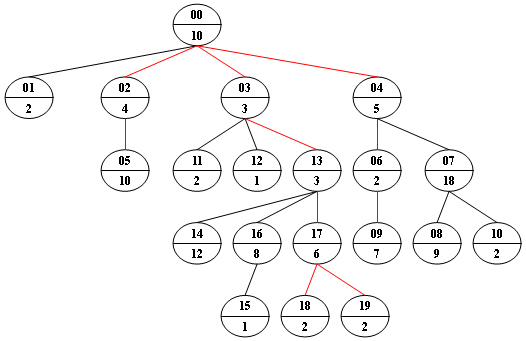DFS 取和为s的路径
1. 原文
Given a non-empty tree with root R, and with weight W**i assigned to each tree node T**i. The weight of a path from R to L is defined to be the sum of the weights of all the nodes along the path from R to any leaf node L.
Now given any weighted tree, you are supposed to find all the paths with their weights equal to a given number. For example, let’s consider the tree showed in the following figure: for each node, the upper number is the node ID which is a two-digit number, and the lower number is the weight of that node. Suppose that the given number is 24, then there exists 4 different paths which have the same given weight: {10 5 2 7}, {10 4 10}, {10 3 3 6 2} and {10 3 3 6 2}, which correspond to the red edges in the figure.

Input Specification:
Each input file contains one test case. Each case starts with a line containing 0<N≤100, the number of nodes in a tree, M (<N), the number of non-leaf nodes, and 0<S<230, the given weight number. The next line contains N positive numbers where Wi (<1000) corresponds to the tree node Ti. Then M lines follow, each in the format:
1 | ID K ID[1] ID[2] ... ID[K] |
where ID is a two-digit number representing a given non-leaf node, K is the number of its children, followed by a sequence of two-digit ID‘s of its children. For the sake of simplicity, let us fix the root ID to be 00.
output Specification:
For each test case, print all the paths with weight S in non-increasing order. Each path occupies a line with printed weights from the root to the leaf in order. All the numbers must be separated by a space with no extra space at the end of the line.
Note: sequence {$A_1$,$A_2$,⋯,$A_n$} is said to be greater than sequence {$B_1$$B_2$,⋯,$B_m$} if there exists 1≤k<min{n,m}such that $A_i$=$B_i$ for *i*=1,⋯,*k*, and $A_{k+1}$>$B_{k+1}$.
Sample Input:
1 | 20 9 24 |
Sample output:
1 | 10 5 2 7 |
2. 解析
按权重从高到低排序,return v[a].weight>v[b].weight;
和为s if (sum==s)
记录路径 path[cnt]=idx;
dfs(temp, sum+v[temp].weight,index+1);
最后一个测试点错误❌:
7 5 8
1 2 2 2 3 3 2
00 2 01 02
01 1 03
02 1 04
03 1 05
04 1 06期待的结果是
1 2 3 2
1 2 2 3
实际的结果是
1 2 2 3
1 2 3 2
因为这种判断逻辑保证的是在同一层结点权值不同时,选择权值最大的结点。但是同一层有权值相同的结点时,选择的结点下一层孩子结点权值可能不是该同层最大的
需要对结果也进行排序,
greater<T>在排序中是将数组元素从大到小排序
3. AC代码
1 |
|